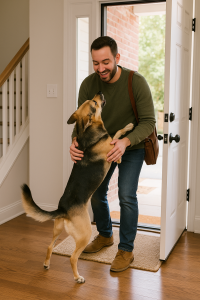
To stop your dog from jumping, practice the desired behaviors before your guests arrive.
A dog who jumps up on guests, puts paws on your clothes, or greets every visitor with enthusiasm is not being “bad,” they’re simply trying to connect the only way they know how, by getting closer to your face in an attempt to get your attention. Jumping is communication, not defiance. The good news? You can teach your dog to greet calmly without scolding, shoving, or using punishment.
Let’s look at why dogs jump, what doesn’t work, and how to build polite greetings that last.
Why Dogs Jump Up
Most dogs jump because it works, even if it’s just for a second. When you push them away, speak loudly, or laugh, they get exactly what they wanted: attention. Puppies often learn this as soon as they can reach your knees. We think it’s adorable that our puppy jumps up and wants our attention, and we give them exactly what they want. Then they grow into a 60-pound dog who is body slamming us and our guests. That behavior, which was adorable when they were puppies, is no longer welcome or safe.
Jumping is rooted in instinct, not disobedience. By changing how we respond and what we reward, we can replace jumping with calmer choices.
Why Punishment Backfires
Yelling “off!” and dragging your dog away from your guests by their collar, or kneeing your dog in the chest, doesn’t teach what to do; it only adds confusion and sometimes fear. Dogs repeat what’s rewarding and avoid what’s scary, but fear-based “corrections” can make greetings stressful and erode trust.
Force-free training emphasizes communication over confrontation. When dogs understand exactly what earns your attention, they begin to offer that behavior willingly, because it feels good.
Step-by-Step: Teaching Polite Greetings
1. Manage the Situation First
If your dog jumps on guests, set them up for success before the doorbell rings. Use baby gates, leashes, or station training (“place” mats) so they can observe calmly. Preventing the rehearsal of the jumping habit is key; every time they practice it, it becomes stronger.
2. Reinforce Four Paws on the Floor
Anytime your dog approaches with all four feet on the floor, calmly mark that moment (“Yes!” or click) and reward. Make sure rewards appear at ground level, toss a treat to where their paws are, not from above, which can accidentally trigger another jump.
3. Teach an Incompatible Behavior
Ask for a behavior that physically prevents jumping, like “sit” or “hand target.” Practice in low-stress situations first, such as when you walk in from another room, before guests are present. Reward calm eye contact and relaxed body language.
4. Keep Greetings Predictable
Ask friends and family to follow the same plan:
- Wait until the dog is calm.
- Step forward only when paws are on the floor.
- Step back or turn away the instant jumping begins.
Consistency teaches that calm behavior leads to good things happening; jumping makes people briefly disappear.
5. Practice Real-Life Scenarios
Once your dog masters calm greetings with family, invite one or two cooperative friends to practice. Keep sessions short, fun, and full of success. Gradually increase excitement, such as a doorbell ringing, laughter, or movement, constantly reinforcing the calm response.
Pro tip: Don’t wait until guests arrive to work on polite greeting. Schedule practice sessions with friends and family so your dog learns the behavior in a calm, structured setting.
Bonus: What to Do When Guests Visit
Before visitors arrive, give your dog an enrichment toy or a short sniff walk to burn off energy. Have treats ready near the entryway. When guests come in:
- Keep your dog on a leash for control and safety.
- Cue a “sit” or “place” and reward heavily for staying calm.
- Let guests greet only when your dog’s body language indicates “ready”: loose muscles, soft eyes, and a tail wag at mid-height.
If your dog gets too excited, no problem. Guide them back to their mat or give them space, and then try again later. Every calm success builds the next.
Polite Greetings Take Practice
Teaching polite greetings is about progress, not perfection. Dogs don’t wake up one morning deciding to jump less; they learn through repetition, consistency, and clarity.
At Dances With Dogs, we use positive, force-free methods that respect each dog’s emotional needs. Whether your goal is calm greetings or confident leash manners, we help you build lasting results rooted in kindness.
Key Takeaways
- Jumping is a normal canine behavior, not disobedience.
- Punishment adds stress and confusion; clear rewards teach faster.
- Reinforce what you want: calm, four paws on the floor, or a polite sit.
- Consistency is your best friend; everyone should follow the same plan.
